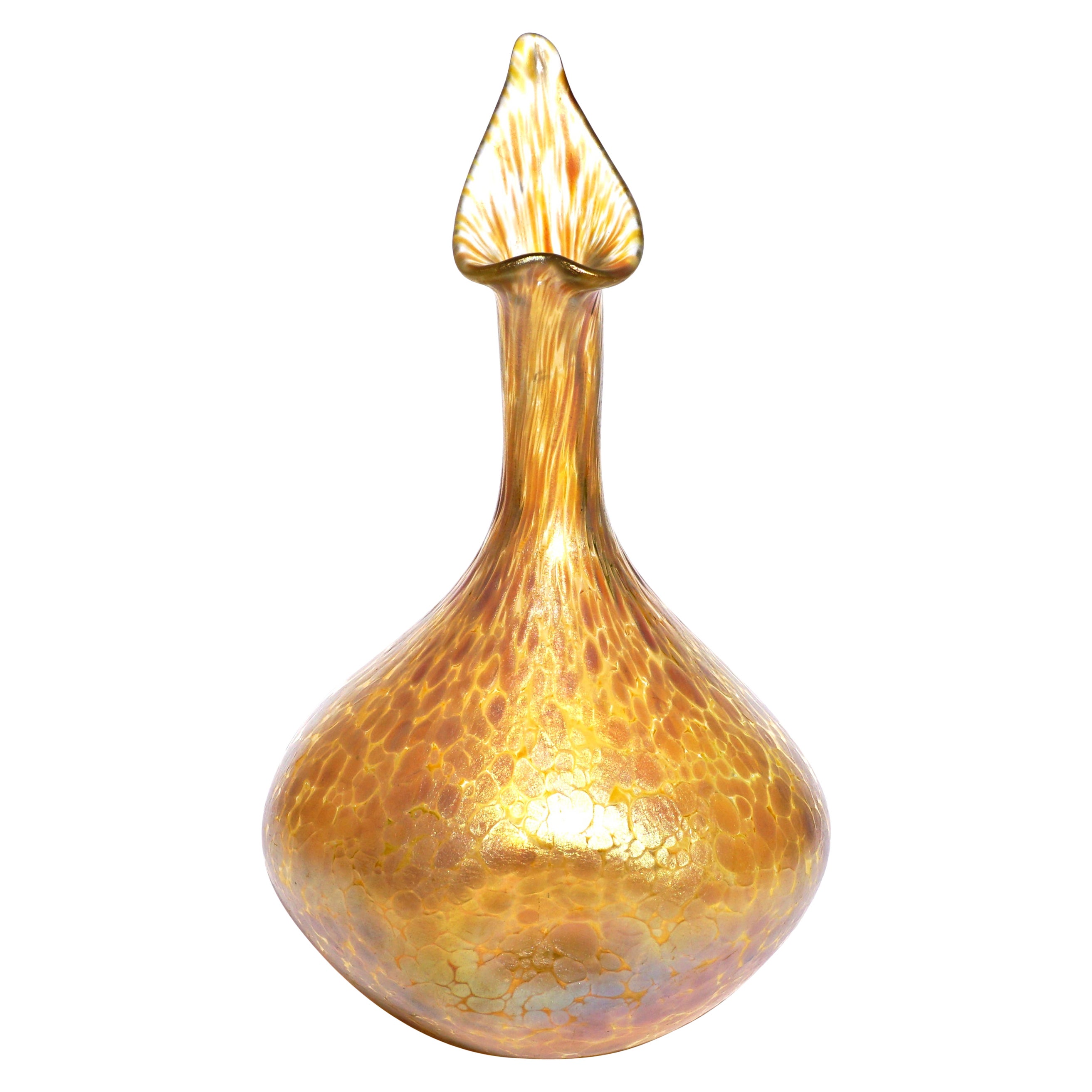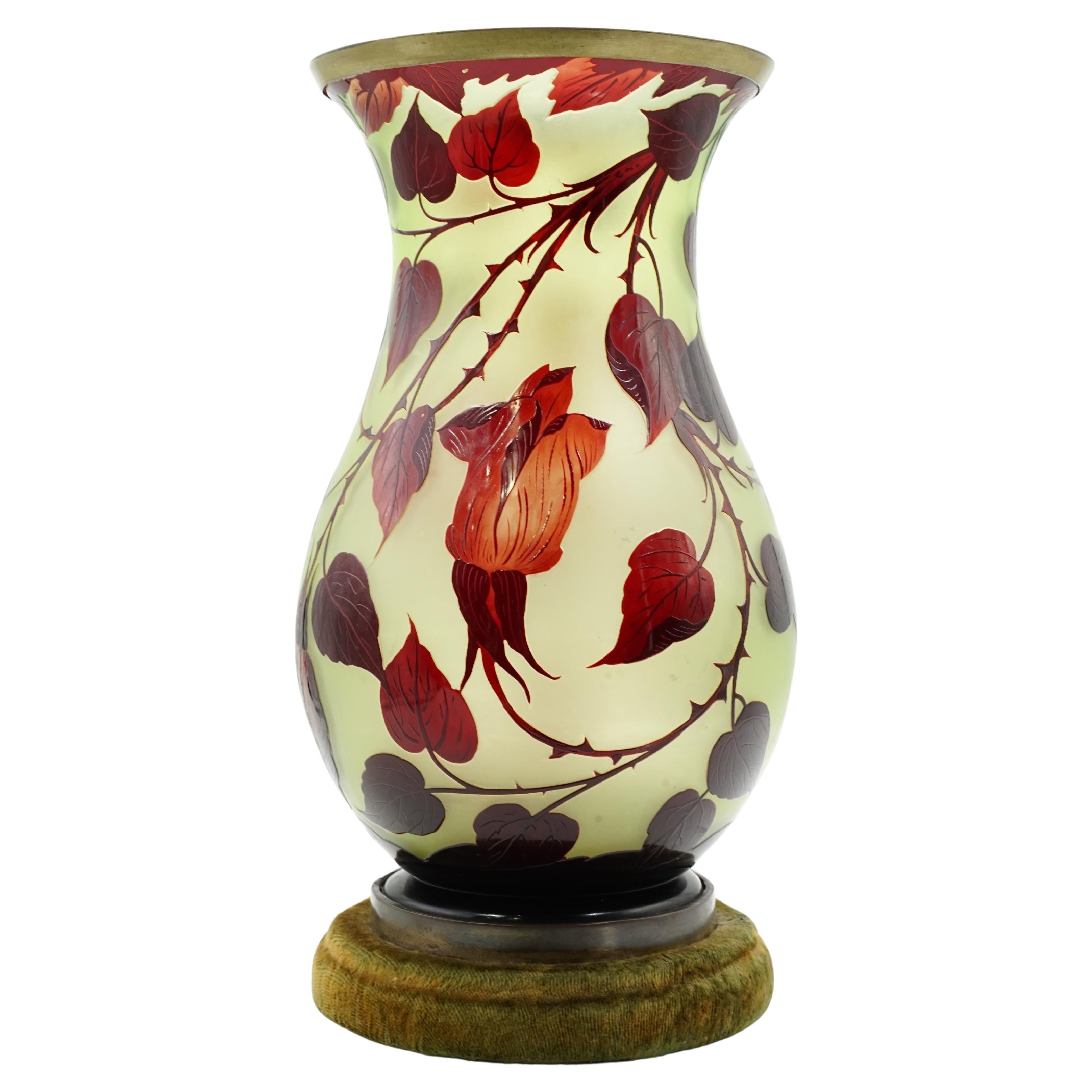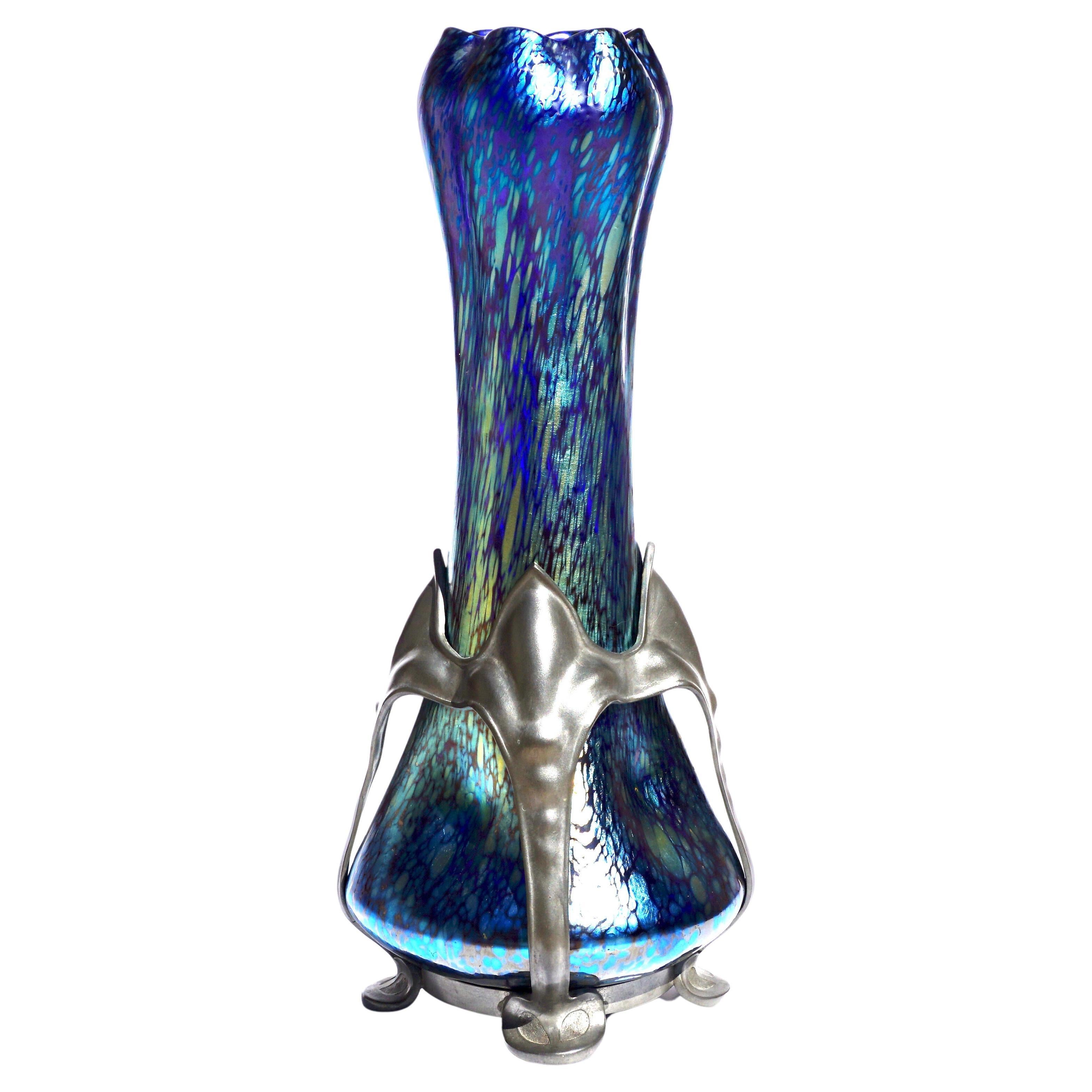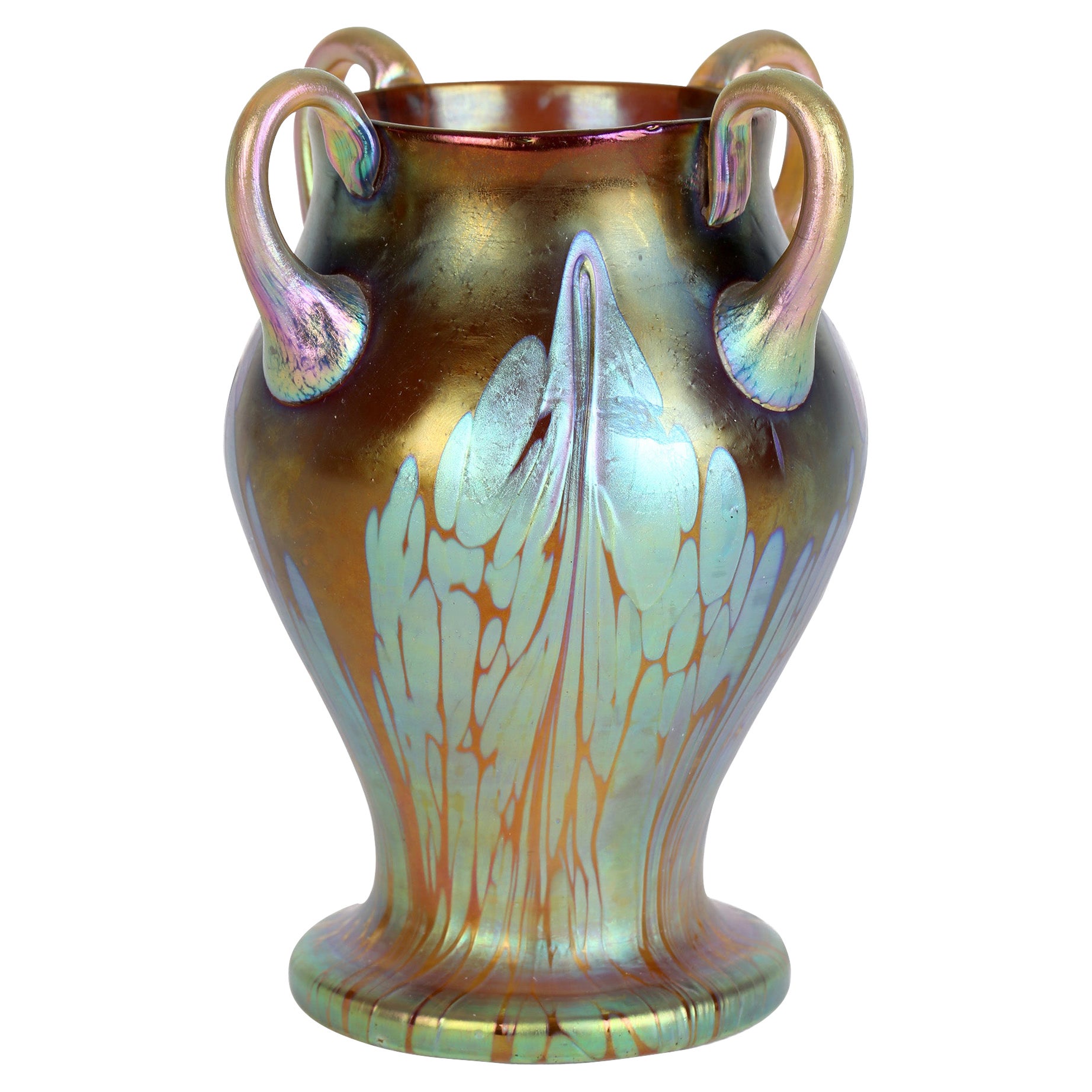Items Similar to Loetz Astraea Art Nouveau Glass Vase
Want more images or videos?
Request additional images or videos from the seller
1 of 7
Loetz Astraea Art Nouveau Glass Vase
About the Item
A large Loetz Astraea glass case Circa 1905
A lovely yellow and oil spot decor "Astraea" vase by Loetz. The glass vase is cylindrical in form with a three-lobed mouth. The background is a translucent yellow with moderate iridescence, further decorated with darker yellow “oil spots”. A wonderful decorative vase to add to your Art Deco- Art Nouveau collection
Excellent condition, free of cracks, breaks, chips or repairs.
Dimensions: 10 - 3/4" x 6" x 6".
AVANTIQUES is dedicated to providing an exclusive curated collection of Fine Arts, Paintings, Bronzes, Asian treasures, Art Glass and Antiques. Our inventory represents time-tested investment quality items with everlasting decorative beauty. We look forward to your business and appreciate any reasonable offers. All of our curated items are vetted and guaranteed authentic and as described. Avantiques only deals in original antiques and never reproductions. We stand behind our treasures with a full money back return if the items are not as described.
Loetz was the premier Bohemian art glass manufacturer during the Art Nouveau period (or Jugendstil, as it was called in German-speaking countries) from roughly 1890 to 1920. Founded in 1840 by Johann Loetz in what is now the Czech Republic, the company became known for its innovative techniques, organic forms, and bold use of color.
Before Loetz became known for its Phänomen and "oil spot" pieces, it had pioneered a surface technique called Marmoriertes, which produced a marbled red, pink, or green surface on objects such as vases and bowls. Another late-1880s precursor to its most prized works are the Octopus pieces, whose white curlicue lines on a darker, mottled surface was thought to resemble the tentacles of octopi.
By 1889, Loetz was one of the region’s leading glassmakers. That year, the company took first prize at the Paris Exhibition for its classic vase forms, some of which were hand-worked and deformed into swirling, organic-looking shapes like seashells, flowers, and tree trunks. Decorative vases, cups, and pitchers were other popular forms in the Loetz lexicon, and many of the pieces practically glowed thanks to their iridescent sheen from the firing and reduction techniques that were popular at the time. For its contributions to the field, Loetz was awarded the grand prize at the Paris World Exhibition in 1900.
One of the most beautiful and collectible Loetz series from this period is called Phänomen, whose chief characteristic is the rippled or featherlike designs on the object’s surface. Loetz artisans achieved this unique effect by wrapping hot glass threads around an equally hot molten base. The threads were then pulled on the object’s surface to make waves and other designs while the materials were still malleable.
The company patented the Phänomen technique in 1898 and used it in combination with techniques pioneered by L.C. Tiffany in the United States—in particular, Tiffany’s iridescent Favrile work.
Please also consider Avantiques eclectic Art Glass and Pate De Verre collection including Emile Galle, Daum Nancy, Schneider, Argy Rousseau, Almeric Walter, D’Argental, St Louis, Decorchemont, and Louis Comfort Tiffany Studios. We strive to collect the highest quality Glass pieces in exceptional condition.
- Creator:Loetz Glass (Manufacturer)
- Dimensions:Height: 10.75 in (27.31 cm)Diameter: 6 in (15.24 cm)
- Style:Art Nouveau (Of the Period)
- Materials and Techniques:Art Glass,Fired
- Place of Origin:
- Period:1900-1909
- Date of Manufacture:1900
- Condition:Wear consistent with age and use.
- Seller Location:Dallas, TX
- Reference Number:1stDibs: LU1774225142582
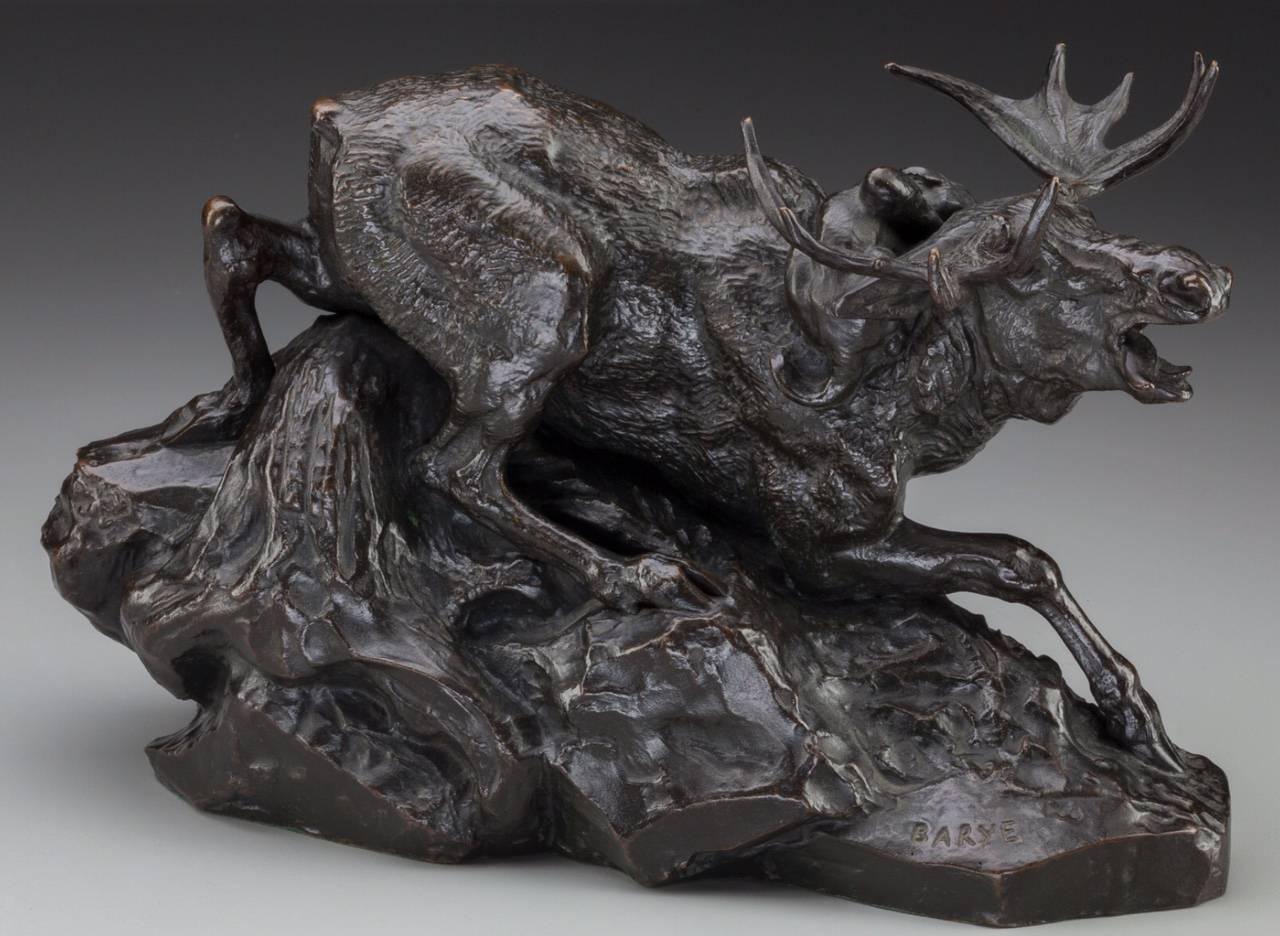
About the Seller
4.9
Gold Seller
These expertly vetted sellers are highly rated and consistently exceed customer expectations.
Established in 2000
1stDibs seller since 2015
402 sales on 1stDibs
Typical response time: 1 hour
- ShippingRetrieving quote...Ships From: Dallas, TX
- Return PolicyA return for this item may be initiated within 7 days of delivery.
More From This SellerView All
- Loetz Candia Papillon Art Nouveau VaseBy Loetz GlassLocated in Dallas, TXLoetz Iridescent and oil spot Flared Neck Art glass Floriform Goose neck vase. Candia Papillon vase Austria Iridescent glass Unsigned Circa 1898 A...Category
Antique 1890s Czech Art Nouveau Vases
MaterialsArt Glass
- Loetz Cobalt Papillon Art Nouveau VaseBy Loetz GlassLocated in Dallas, TXA Loetz Cobalt Papillon Art Glass and Pewter Art Nouveau Vase. Circa 1900 The shapely design with flared base having four evenly spaced indentations...Category
Antique Early 1900s Czech Art Nouveau Vases
MaterialsPewter
- Loetz Cobalt Papillon Art Nouveau VaseBy Loetz GlassLocated in Dallas, TXThis Loetz vase in the Cobalt Papillon pattern has blue iridescent Papillon design covering the exterior of the vase. Vase is signed on the polished ...Category
Antique Early 1900s Austrian Art Nouveau Vases
MaterialsArt Glass
- Loetz Silver Overlay Art Nouveau Vases PairBy Loetz GlassLocated in Dallas, TXLoetz Art Nouveau circa 1900 art glass vases with floral and decorative scroll Silver Overlay. (Pair) Larger: Corset form in iridescent gold glass decorated with scrolling silver overlay and a blank cartouche. Height: 5.25 X 2.75 Diameter Condition: Mint. Smaller: Bulbous smoke stack form in iridescent green-gold decorated with scrolling silver overlay flowers. Marked: Alvin pat 67 Height: 4.25 X 2,65 Diameter Condition: Mint AVANTIQUES is dedicated to providing an exclusive curated collection of Fine Arts, Paintings, Bronzes, Asian treasures, Art Glass and Antiques. Our inventory represents time-tested investment quality items with everlasting decorative beauty. We look forward to your business and appreciate any reasonable offers. All of our curated items are vetted and guaranteed authentic and as described. Avantiques only deals in original antiques and never reproductions. We stand behind our treasures with a full money back return if the items are not as described. In 1836, Johann Eisner established a glassworks in the Southern Bohemian town of Klostermühle, today part of the Czech Republic and called Klášterský Mlýn. His heirs sold the glassworks to Martin Schmid in 1849, and two years later Schmid sold it to Frank Gerstner, attorney-at-law, and his wife Susanne. Susanne was the widow (‘Witwe’ in German) of Johann Loetz, a glassmaker about whom we know very little. Gerstner transferred sole ownership to Susanne shortly before his death in 1855, and she successfully led and expanded the company during the subsequent 20 years, manufacturing mainly crystal, overlay and painted glass. In 1879, Susanne transferred the company – now called ‘Johann Loetz Witwe’ – to Maximilian von Spaun, the son of her daughter Karoline. One year later, von Spaun hired Eduard Prochaska and the two of them modernized the factory and introduced new, patented techniques and processes. The first fruits of this collaboration were exciting innovations in Historicism glass, including Intarsia and Octopus glass and the very popular marbled (‘marmorisierte’) glass which imitated semi-precious stones like red chalcedony, onyx and malachite. Success at exhibitions in Brussels, Munich and Vienna were crowned by awards at the Paris World’s Exposition in 1889. In 1897, von Spaun first saw Tiffany Favrile glass exhibited in Bohemia and Vienna, and this convinced him that the art nouveau style was also the way to go for Loetz Witwe. The next eight years were to be the most artistically significant and profitable period in the entire history of the company. The Art Nouveau Period –The glassworks created large numbers of its own new designs of iridescent, trailing art nouveau glass, sometimes in collaboration with well-known artists and designers like Marie Kirschner and Franz Hofstötter (aka Franz Hofstätter). The zenith of Loetz art nouveau glass was epitomized by the so-called Phänomen series of designs, much of it designed by Hofstötter, which won a Grand Prix (alongside Tiffany, Gallé, Daum and Lobmeyr) at the Paris World’s Exposition in 1900. The company’s success during this period had two prime drivers – the technical expertise of Prochaska and the business acumen of von Spaun. Loetz Witwe created many of its own designs, and also supplied glass commissioned by major customers like E. Bakolowits (Vienna) and Max Emanuel...Category
Antique Early 1900s Austrian Art Nouveau Vases
MaterialsArt Glass
- Loetz Glatt Bronze Three Handled Glass VaseBy Loetz GlassLocated in Dallas, TXLoetz Three Handle iridescent glass vase in the Glatt Bronze design, handles applied with raspberry prints. Height: 6.5 Inches. Diameter: 6 Inches Condition; Very good Johann Loetz W...Category
Antique Early 1900s Austrian Art Nouveau Vases
MaterialsArt Glass
- Loetz Candia Papillon Three Handled VaseBy Loetz GlassLocated in Dallas, TXLoetz Candia Papillos three handled vase. Austria Circa 1910 Measures: Height: 5.75 inches Diameter: 5.5 inches Condition Excellent with no issues. AVANTIQUES is dedicated to providing an exclusive curated collection of Fine Arts, Paintings, Bronzes, Asian treasures, Art Glass and Antiques. Our inventory represents time-tested investment quality items with everlasting decorative beauty. We look forward to your business and appreciate any reasonable offers. All of our curated items...Category
Vintage 1910s Austrian Art Nouveau Vases
MaterialsArt Glass
You May Also Like
- Rare Loetz Art nouveau glassBy Loetz GlassLocated in Buenos Aires, ArgentinaRare Loetz Art nouveau glass Artist Loetz (has another signature for export to other markets) Origin Austria Crica 1900 Excellent condition without restorations It is signed J Massi ...Category
Antique Early 1900s Austrian Art Nouveau Vases
MaterialsArt Glass
- Loetz Art Nouveau Four Handled Phaenomen Iridescent Art Glass VaseBy Loetz GlassLocated in Bishop's Stortford, HertfordshireAn exceptional and rare Bohemian art nouveau Phenomen Genre 2/484 (also known as Medici) pattern Loetz vase dating from around 1902. This beautiful vase stands on a rounded spread fo...Category
Antique Early 1900s Austrian Art Nouveau Vases
MaterialsBlown Glass
- Art Nouveau Loetz Iridescent Glass Vase with Silver OverlayBy Loetz GlassLocated in Buenos Aires, OlivosArt Nouveau glass vase with engraved silver overlay by historic Czech maker Loetz.Category
Early 20th Century Austrian Art Nouveau Vases
MaterialsSterling Silver
- Loetz Glass "Titania" Art Nouveau Green Silver Overlay VaseBy Loetz GlassLocated in Miami, FLA fine quality Art Nouveau art glass vase, by Loetz the historic glass maker from the municipality of Austria featuring engraved Alvin Sterling Silver overlay. Overlay in form of op...Category
Antique Late 19th Century Austrian Art Nouveau Vases
MaterialsGlass, Art Glass
- Austrian Loetz Iridescent Art Nouveau Glass Vase Sterling OverlayBy Loetz GlassLocated in Toledo, OHAustrian Loetz iridescent art glass vase in papillon finish with sterling silver applied overlay. Art Nouveau style in a dimpled form shades of green ...Category
Early 20th Century European Art Nouveau Vases
MaterialsGlass
- Loetz Art Nouveau Jugendstil Art Glass BowlBy Loetz GlassLocated in Miami, FLA stunning Loetz art glass green bowl decorated with gold inclusions. The glass manufacturer Loetz after their big success at the Paris World Exhibition in 1900. While creating decoration variants, the owner of the glass workshop, Max Ritter von Spaun, was presumably inspired by works of Louis C. Tiffany. The applied applications by Loetz are positioned more prominently and have their own ornament in the form of pulled iridescent threads. This glass work of art known as Loetz Jugendstil...Category
Early 20th Century Austrian Art Nouveau Vases
MaterialsGlass, Art Glass
Recently Viewed
View AllMore Ways To Browse
Art Nouveau Glasses
Art Nouveau Art Glass
Exhibition Glass
Antique Looking Glass
Antique Looking Glasses
Glow Glass
Antique Glass Repair
Hot Glass
Art Nouveau Antique Glass
Antique Firing Glass
Firing Glasses Antique
Green Orange Glass
Orange And Green Glasses
Orange And Green Glass
Antique Orange Glass
Orange Antique Glass
Glass Art Green Large
Glass Art Waves
